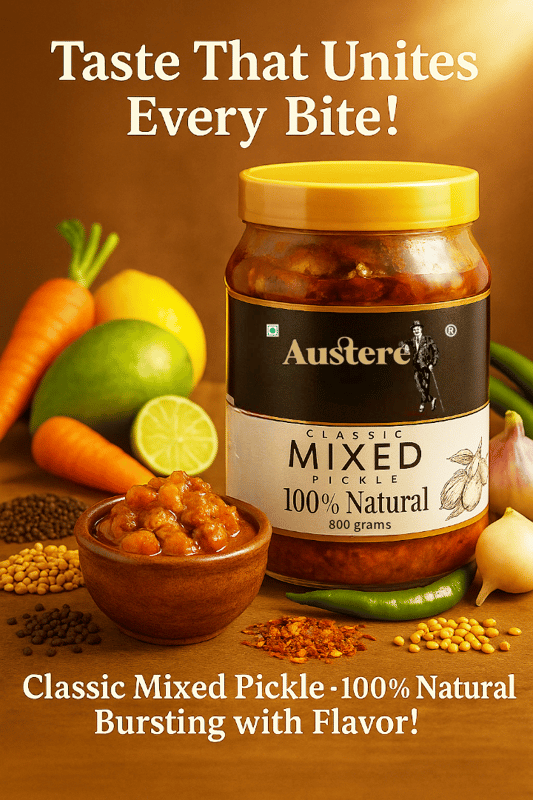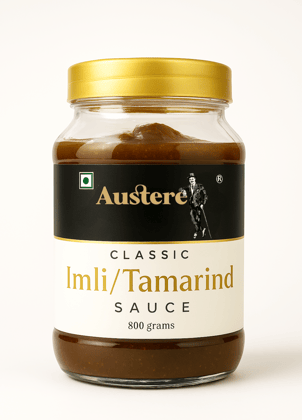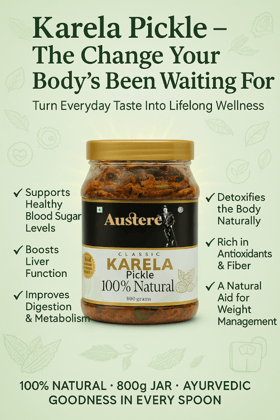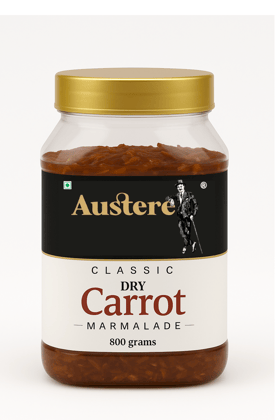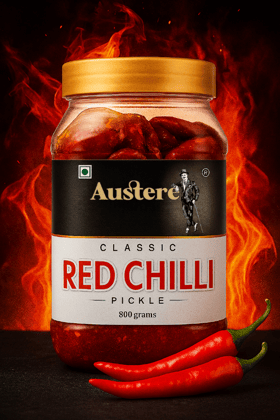Ingredients:
- Vegetables: Common vegetables used in mixed pickle include carrots, cauliflower, green mangoes, lime, turnips, and green chilies.
- Fruits: Some recip...
MIXED PICKLE/ FULL OF multiple vegetables
Veg
Key Attributes
| Country of origin | India |
|---|---|
| Brand | AUSTERE STORE |
| Net Quantity | 800 gram |
| Product Dimensions | 12L x 12W x 12H cm |
Ingredients:
- Vegetables: Common vegetables used in mixed pickle include carrots, cauliflower, green mangoes, lime, turnips, and green chilies.
- Fruits: Some recipes may include fruits like raw papaya or even berries for added sweetness and tartness.
- Spices: Mixed pickle is characterized by a mix of aromatic spices such as mustard seeds, fenugreek seeds, cumin seeds, fennel seeds, asafoetida (hing), turmeric, red chili powder, and sometimes nigella seeds (kalonji).
Preparation:
- Chopping: Vegetables and fruits are typically chopped into bite-sized pieces or slices.
- Spice Blend: The chopped ingredients are then mixed with a spice blend, and sometimes oil and vinegar or lemon juice are added to create a pickling liquid.
- Fermentation: Some mixed pickles undergo a fermentation process, allowing the flavors to intensify over time.
Flavor Profile:
- Spicy: Mixed pickles are known for their bold and spicy flavor due to the combination of various spices.
- Tangy: The use of souring agents like raw mangoes or lime adds a tangy element to the pickle.
- Savory: A combination of savory spices and the inherent umami of fermented pickles contributes to the overall savory taste.
Texture:
- Crunchy: The vegetables and fruits in mixed pickle can maintain a crunchy texture, especially if the pickle is not fermented for an extended period.
Culinary Uses:
- Side Dish: Mixed pickle is commonly served as a side dish with various meals, especially in South Asian cuisine.
- Condiment: It can be used as a condiment to add flavor to rice dishes, flatbreads, or sandwiches.
Regional Variations:
- Diverse Recipes: Different regions have their own variations of mixed pickle, incorporating local ingredients and spices.
- Seasonal Ingredients: The choice of vegetables and fruits may vary based on seasonal availability.
Preservation:
- Long Shelf Life: Mixed pickles have a long shelf life due to the pickling process, allowing them to be stored for an extended period.
Homemade vs. Commercial:
- Customization: Homemade mixed pickles provide the flexibility to customize the spice levels and ingredients. Commercial versions may have variations in flavor and texture.
| Country of origin | India |
|---|---|
| Brand | AUSTERE STORE |
| Net Quantity | 800 gram |
| Additive info | Preservatives: Sodium Benzoate: Sodium benzoate is a commonly used preservative that helps inhibit the growth of microorganisms and extend the shelf life of the pickle. Acidity Regulators: Citric Acid: Citric acid is a natural acid found in citrus fruits and is used as an acidity regulator. It can contribute to the tanginess of the pickle. Emulsifiers or Stabilizers: Modified Food Starch: Modified food starch can be used as a stabilizer to improve the texture and consistency of the pickle. Antioxidants: Ascorbic Acid (Vitamin C): Ascorbic acid may be added as an antioxidant to prevent oxidation and maintain the color of the pickle. Coloring Agents: Turmeric Extract or Annatto: While turmeric powder is a natural ingredient used for coloring, some products might use concentrated extracts or annatto to enhance or standardize the color. Flavor Enhancers: Monosodium Glutamate (MSG): In some processed foods, MSG may be used as a flavor enhancer. However, its use can vary, and many pickles do not contain MSG. Vegetable Oil: Edible Oil: While traditional recipes may use mustard oil, commercially produced pickles may use other edible oils. |
| Batch number | A4 |
| Expiry Date | 100 MONTHS |
| Weight | 850 g |
| Package Dimension | 12L x 12W x 12H cm |
| Product Dimensions | 12L x 12W x 12H cm |
| Food type | veg |
| Ingredients | -Basic Ingredients: -Vegetables: -Carrots: Peeled and sliced into thin rounds or sticks. -Cauliflower: Cut into small florets. -Turnips: Peeled and sliced or cubed. -Bell Peppers: Sliced into thin strips. -Green Chilies: Sliced or kept whole, depending on preference. -Ginger: Peeled and julienned or sliced. -Garlic: Peeled and sliced or minced. -Raw Mango: If making a summer pickle, raw mango pieces can be included for tartness. -Spices: -Mustard Seeds: Whole mustard seeds are often used for their distinct flavor. -Fenugreek Seeds: Adds a slightly bitter taste. -Fennel Seeds: Provides a hint of licorice flavor. -Nigella Seeds (Kalonji): Adds a unique flavor. -Turmeric Powder: For color and flavor. -Red Chili Powder: Adds heat and spice. -Asafoetida (Hing): A pinch for its savory flavor. -Cumin Seeds: Some recipes may include cumin seeds. -Salt: Used for pickling and flavoring. |
| Nutritional information | -Nutritional Content of Mixed Pickle (per serving, approximately 1 tablespoon): -Calories: The calorie content can vary but is generally low, typically in the range of 5 to 15 calories per tablespoon. -Carbohydrates:Total Carbohydrates: Around 1 to 3 grams per tablespoon. -Sugars: The sugar content is generally low but can vary based on the ingredients used. -Fat:Total Fat: Varies based on the amount of oil used. It can range from 0.5 to 2 grams per tablespoon. -Saturated Fat: The saturated fat content can vary depending on the type and amount of oil used. -Protein:Protein content is minimal, typically less than 1 gram per tablespoon. -Dietary Fiber:The fiber content can vary based on the types of vegetables used but is generally low, around 0.5 to 1 gram per tablespoon. -Sodium:The sodium content is typically high due to the use of salt in the pickling process. It can range from 200 to 400 milligrams or more per tablespoon. -Vitamins and Minerals:The mixed pickle may contain small amounts of vitamins and minerals from the vegetables used, such as vitamin C, vitamin A, and various antioxidants. |
| Instructions | ngredients: Vegetables: Carrots (peeled and sliced) Cauliflower (cut into small florets) Turnips (peeled and sliced or cubed) Bell Peppers (sliced into thin strips) Green Chilies (sliced or kept whole) Ginger (peeled and julienned or sliced) Garlic (peeled and sliced or minced) Raw Mango (optional, for tartness) Spices: Mustard Seeds Fenugreek Seeds Fennel Seeds Nigella Seeds (Kalonji) Turmeric Powder Red Chili Powder Asafoetida (Hing) Salt Edible Oil: Mustard Oil (traditional choice) or any other edible oil Instructions: Prepare Vegetables: Wash and thoroughly dry all the vegetables. Peel and slice carrots into rounds or sticks. Cut cauliflower into small florets. Peel and slice or cube turnips. Slice bell peppers into thin strips. Prepare green chilies, ginger, and garlic as desired. If using raw mango, peel and cut it into pieces. Sterilize Jars: Sterilize glass jars and lids by washing them in hot, soapy water or running them through the dishwasher. Prepare Spice Mixture: In a dry pan, lightly roast mustard seeds, fenugreek seeds, fennel seeds, and nigella seeds until they release their aroma. Allow them to cool. Grind the roasted seeds into a coarse powder. In a bowl, mix the ground spice powder with turmeric powder, red chili powder, asafoetida, and salt. Adjust the spice levels according to your preference. Combine Vegetables and Spice Mixture: In a large mixing bowl, combine the prepared vegetables with the spice mixture. Mix well to ensure the vegetables are evenly coated with the spices. Heat Oil: Heat mustard oil (or your chosen edible oil) in a pan until it reaches its smoking point. Allow the oil to cool slightly. Pour Oil Over Vegetables: Pour the slightly cooled oil over the spice-coated vegetables. Ensure that the oil covers the vegetables completely. Pack the Jars: Pack the spice-coated vegetables tightly into sterilized glass jars. Seal the Jars: Ensure the jars are tightly sealed. Allow the pickle to cool completely. Maturation Period: Place the sealed jars in a cool, dark place for the pickle to mature. The maturation period can vary but is typically a few days to a couple of weeks. During this time, the flavors will meld and intensify. Serve and Enjoy: Once the mixed pickle has matured, it is ready to be enjoyed as a flavorful accompaniment to meals. Tips: Use clean and dry utensils and containers to prevent spoilage. Ensure that the vegetables are completely dry before mixing them with the spice mixture to prevent water content in the pickle. Remember that this is a basic guide, and you can adjust the ingredients and quantities based on your taste preferences. Additionally, it's essential to follow proper hygiene practices to ensure the safety and longevity of the homemade pickle. |
| contact details consumer care | AUSTERE STORE, [email protected] |








